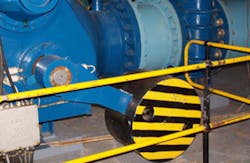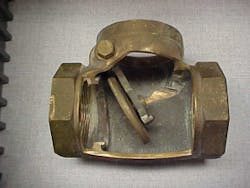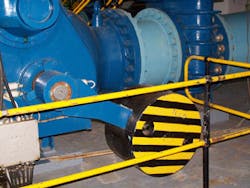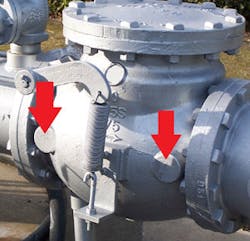(a.k.a. "The Pump Guy")
Larry,
Years ago, I read a book about process valves. The book said check valves belong in the discharge side of a centrifugal pump. A centrifugal pump doesn’t generate enough differential to open a check valve in the suction pipe, especially if the valve is stuck, or spring-loaded. Hence, system flow might not develop. In almost all cases, a centrifugal pump will develop enough pressure to open a check valve mounted into the discharge pipe.
I am presently trying to explain this to some colleagues who insist they can put a check valve in the suction side of a process pump. You are the Pump Guy. What do you say?
Thanks,
John H., P.E.
###
Hello John,
In a process system with pumps and valves, a check valve permits liquid flow in only one direction. A check valve automatically prevents reverse flow when the liquid in the pipe reverses direction. A check valve is unique because it doesn’t require assistance (an operator or actuation) to open and close. The liquid’s energy actuates the check valve.
RELATED: How the Pump Guy Relates to The Three Stooges
RELATED: Do you know where the Pump Guy Seminar will be in 2014? Click here to find out.
The check valve will open with flow in the correct direction. The valve will close with reverse flow. It is a little more sophisticated than simple flow though. The valve will open or close with an energy differential (liquid weight, velocity, or pressure) across the valve.
There are many different types of check valves. You should read the owner’s manual of a specific valve to know how much differential force will open or close the valve.
A cutaway image of a swing check valve for three-inch pipe is provided here. The gate is gravity-loaded. The hinge on the bronze flapper is immediately above the flapper in the closed position. Gravity holds the flapper closed. The flapper weighs maybe 6 or 8 ounces. This valve will crack open with a slight differential force. Without other energy drain, a medium size centrifugal process pump can generate enough differential pressure to open and draw flow through this check valve on the suction side of the pump. (NOTE: I didn’t say I recommend locating check valves on the suction side of a pump.)
A check valve with a 1-ton (2,200 lbs. or 1,000 kg) weighted arm holding the valve shut is also provided here. It will require some serious differential energy to raise that weight and the gate to the fully open position. This check valve will starve a medium-sized process centrifugal pump.
A process check valve belongs on the discharge side of a process centrifugal pump. The pump (speed, impeller diameter, power) must be designed so the pump can overcome the energy needed to fully open the check valve.
The spring-loaded check valve pictured here is cast with bosses prepared to have pressure indicators installed into the entrance and exit of the valve. What does it mean if the plant engineer doesn’t order to install gauges into the bosses?
The pump’s discharge pressure (head) must create enough differential energy across the check valve to fully open the valve. The differential pressure across the check valve indicates the energy the valve will eat. The pressure at the valve’s exit nozzle must be adequate to overcome the downstream resistance in the system and move the liquid to the next stage in the process.
A check valve on the suction side of a centrifugal process pump will likely starve the pump of energy. Now having said that, some lift type pumps have what they call a “foot valve” on the suction pipe. This is a type of check valve because it only allows flow in one direction. However, a foot valve is normally mounted in a vertical pipe below the water line so the weight of the liquid resting on the flapper holds it shut until the pump is started. The foot valve prevents losing the column of liquid in a lift pump so the pump stays primed. Another thing … the flapper on a foot valve is not spring-loaded or weighted. Some flappers in foot valves are neutrally buoyant.
I mention this because a purist might claim this is a check valve designed to be mounted into the suction side of a pump.
Good luck with your colleagues,
Larry Bachus
We discuss and compare all types of valves in the Pump Guy Seminar Series presented by Flow Control magazine. We have upcoming seminars in Lake Charles, La. and Portland, Ore. in 2014. Come if you can. For full details on the Pump Guy Seminar, visit FlowControlNetwork.com/PumpGuy or contact Matt Migliore at [email protected], 601. 828.1711.
Larry Bachus, founder of pump services firm Bachus Company Inc., is a regular contributor to Flow Control magazine. He is a pump consultant, lecturer, and inventor based in Nashville, Tenn. Mr. Bachus is a retired member of ASME and lectures in both English and Spanish. He can be reached at [email protected].






